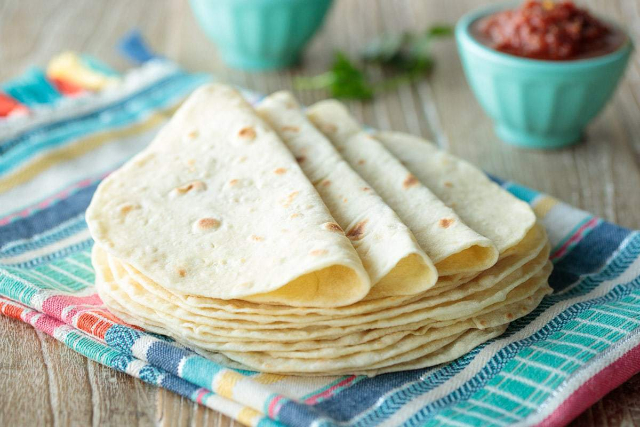Yesterday, we looked at one dumpster diver’s midnight expedition to a Whole Foods outlet, where she discovered all sorts of perfectly good food, tossed for ‘political’ reasons. Today, we take another angle on the same phenomenon: House brands that scavenge name brands…
 Perfect Flour Tortillas: The way they should be.
Perfect Flour Tortillas: The way they should be.
Before I get going on this aggravating issue, let me declare that I cannot prove my contentions as outlined hereinafter, but the evidence is strong, and I invite any retailer which thinks it might be the one I’m talking about to get in touch and present its side of the story.
This post, therefore, is purely an exercise in, “What if?”
A little history…
There was a time, decades ago, when supermarkets started selling packaged foods under their own labels, rather than simply reselling products from independent and national brands. Consumers were at first skeptical about the quality and wholesomeness of the ‘house brand’ products, speculating they were substandard or somehow second rate. That may have been the case in the beginning, but not now. Most consumers now know that house brand foods are subject to the same rigid quality control standards as name brands. And massive numbers of consumers buy them on a regular basis, confident that they can safely save some money over the cost of the name brands.
Today…
I am going to delve into an issue I’ve been thinking about for a long time: Are some house brand products actually second rate? Quality control rejects sold as first-quality? One product in particular has me concerned.
A staple in my house
I always have large flour tortillas in the house. Along with premium bagels and really good bread. You’ve probably read one or two of my posts about the oddball combinations I’ve tried for breakfast burritos. That’s just one dimension of tortilla use under my roof. Tortillas are important, period. And they have to be consistent in size, shape, thickness, flavour and bite. This is where my current source is failing me.
Some unwritten rules of retailing
I have been delegating the grocery shopping to sister Erin for some timed, now, since my elderly mother began to require full-time care-giving. And I kind of lost track of the point of view I previously enjoyed vis-a-vis comparison shopping.
A quick product comparison confirms that our source’s house brand tortillas are inferior to the name brand ones displayed right beside them, on a number of accounts. But they are often priced the same as or higher than their name brand equivalents. But many factors can effect pricing – as well as availability. It’s a well-known retailer practice to take house brand products off the shelves temporarily to make room for higher-priced equivalents whose manufacturers have paid extra for prime display conditions, and want the lower-priced house brands to be unavailable. Or the prices of the house brands are artificially elevated to make the name brands look like better buys.
But that’s not the issue
The issue is, the house brand tortillas fail to meet a whole list of ‘standards’ that tortilla makers strive to achieve, in their goal of producing a first-class product. Kremin Food Systems has even published a Troubleshooting Guide for Tortilla Makers to help them diagnose and cure issues with their production systems.
Among the ills that can afflict the common flour tortilla: breaking, cracking, zippering (tearing), off size, off shape, transparency (too thin), inconsistent thickness (feathering or lacing on one side), and ‘rollability’ issues. Not to mention over- or under-baking.
I’ve been noticing inconsistencies
Lately (actually, for the past few months) I’ve been noticing inconsistencies in the house brand tortillas from my usual source. In one packet of 10, diameters may vary by up to 3 cm, and random tortillas may be off round by as much as 3 – 4 cm on the longer dimension. It’s usually these oversized and off-round specimens that have a thin or lacy edge at one or the other apex of their oval. You can only spread dough so far before it gives. Thinning and lacing directly effect rolability and, thus, the appearance and structural integrity of the finished product. Not to mention the wars that may arise in other households – where there are children – when Jimmy complains that Johnny’s burrito is bigger than his. No parent should have to umpire one of those!
By comparison…
The name brand tortillas displayed right beside the house brand are consistently round, and the same diameter (within a few millimetres). They never show any lacing or thinning. And their rolability is unquestioned. They’re just about as perfect as a customer has a right to expect. And they are indistinguishable from the best of the house brand tortillas.
But, if the issues covered in the Kremin Troubleshooting Guide are so common that a formal reference for resolving them is needed, where do the inevitable quality control rejects go? I suppose there was a time when the maker (who now shadow-bakes for the house brand) culled the imperfect tortillas and tossed them. But it strikes me as possible that, now, they’ve come to an agreement with the retailer to bag up the least-offensive of the rejects under the house brand label. And wholesale them to the retailer in question at a cut-rate price. The name brand maker also wins because it can now sell stuff it used to toss and take a loss on, and it can charge more for its product, since it’s perceived as higher-quality than the house brand.
Am I paranoid?
Or are they really out to get me? The age-old question… But this wouldn’t be the first time Canadian mega-bakeries got overly cozy with retailers on bread marketing.
~ Maggie J.

